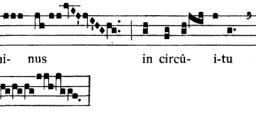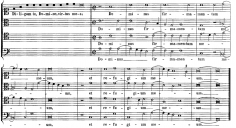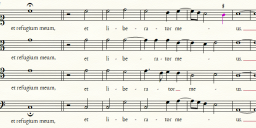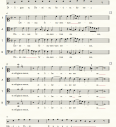Isaac's Choralis Constantinus
-
Ah, very nice.
Yes, I'm focusing specifically on Communion propers right now, since they are most likely to be of use to most people. I'm hoping to finish those for the Easter Season soon.
(after that, I'm not sure when I'll have more time to work on these) -
Going back to my previous post ... My personal, text-only hand missals say "Cum venerit" - so is it possible that these cum - dum changes were made specifically for (supposedly) musical reasons?Thanked by 1tomjaw
-
@CCooze
I too looked in one Hand Missal 1962 and found "Cum venerit", I then looked in my Missale Romanum, I could look in my other Handmissals from 1880-1960 but I am sure they will all have Cum.
Perhaps the M.R. text was Cum and the G.R. text was Dum? -
I think I'm finally to the point where I can start working on this again (baby + computer crashed and I finally reinstalled Finale). Before I start on my own schedule, is there any particular proper(s) from CC I or II anyone is interested in seeing in modern SATB form in the near-er future?
-
Our director is interesting in us singing on Pentecost XVII. I am told the Introit is already done, but I am asked if you could transcribe the Communion, Vovete a minor third down from written, that would be great.
We are looking forward to celebrating the anniversary next year! -
Thanks @ CCooze that is "Perfect" according to our director.Thanked by 1CCooze
-
Isaac's Advent I (introit, alleluia, communio) propers are now on CPDL.
"Ostende Nobis, Domine" - the alleluia verse - would make a lovely "Mercy"-themed motet during the year, as well. -
@CCooze Thanks so much we sang Vovete on Pentecost XVII, it really is a wonderful piece. http://www1.cpdl.org/wiki/index.php/Vovete_(Heinrich_Isaac)
We next intend to sing on Pentecost XXIII, but as my wife will be close to her due date, we will not have a soprano... and will be singing a ATTB, So our choir director asks, "could you produce transposed versions of the Introit (Dicit Dominus) and Alleluia (De profundis) for Pentecost XXIII? I'd like them transposed down a major third and a tone respectively from the versions she's already posted online." -
Congrats on the baby. =)
My youngest is 5 months today. -
-
number 7, to join the one girl and 5 boys.
Hmm, I had a daughter, followed by 6 sons. After thar, gave up trying to get another daughter.Thanked by 1tomjaw -
I am the 7th child of 11.
My parents' 2nd child was a boy, as were numbers 8, 10 & 11. You just never know.
So far, I have 3 sons. -
@CCooze Once again many thanks for the XXIII Sunday after Pentecost editions, we sang them on Sunday!
Sadly no recordings... but I hope to arrange that we will be recording our efforts over the 500th Anniversary year. -
is there any particular proper(s) from CC I or II anyone is interested in seeing in modern SATB form in the near-er future?
@CCooze
Have just been looking at next year, I see we have 5 Sundays after Epiphany... the propers for Sundays 3-5 are all the same, so could we ask for the following to be set...
Domenica II p. Epiphaniae
INT. Adorate Deum
ALL. Dominus regnavit
COM. Mirabantur omnes
Also Heinrich Isaac (c. 1450 – 26 March 1517) N.B. the 26th of March 2017 is Laetare Sunday, I see you have already set the Communion, could we please have the
INT. Laetare Jerusalem
and
TRACT. Qui confidunt
Thanked by 1CCooze -
All, I will be uploading an updated version of the "Omnes Sancti" sequence in the near future (hopefully tonight or tomorrow).
Until then, other than some minor changes, for any working on this piece, please disregard the tenor part from measures 70-92, as they are incorrect(, and instead have your tenors join the basses, should such an addition be necessary).
Thanks! (and sorry - this is because of a misprint in the printed edition of this vol. II collection, which I only just realized) -
The sequence has been updated on CPDL: Omnes Sancti
-
@tomjaw - I will try to get to these soon.
(baby + Finale = more difficult than holding baby + singing Mass parts into microphone) -
-
Also, here's a rehearsal recording I was sent by a choir which sang the Omnes Sancti sequence for All Saints. =)
Omnes Sancti Seraphim -
My wife is back singing with us so we have our Soprano back!, well when she is not looking after a 2 month old... Although she can thankfully sing and breast feed!
SATB will be fine,
Many thanks! -
Epiphany III propers are up on CPDL.
(just let me know if you think an ATTB may be necessary for the introit.. I will try to get to it) -
How many others are planning for this commemoration year? Here's Introibo ad altare for Sexgesima/OT5.
-
I have been pestering various choirs in England! Will post any events here.
I wonder if any choir is going to produce professional recordings, although having recordings on youtube would be great! -
I'll start Laetare Sunday, next. Hopefully, we'll be able to use it, as well!Thanked by 1tomjaw
-
We are working on using the the EPIII Propers on Epiphany 4 or 5.
Will be great to have the Laetare... and it will be the 500th!Thanked by 1CCooze -
it will be the 500th
I wonder if CCWatershed will mention anything about this.Thanked by 1tomjaw -
Tract: Qui confidunt in Domino
Isaac is missing "et Dominus in circuitu populi sui." I've considered just moving the text around, because there's plenty of music to do it, but the text is so obviously following its respective chant in both the "Montes in circuitu eius" before, and the "ex hoc nunc et usque in saeculum" after.
I'm assuming it would look odd to have this much chant just past 2/3 of the way through, but then end with the polyphony? I know I had 2 pages of chant in the midst of Palm Sunday's tract, but this just seems slightly awkward.
 piece.jpg596 x 204 - 35KThanked by 1tomjaw
piece.jpg596 x 204 - 35KThanked by 1tomjaw -
I took the liberty of supplying my own, simplified version of the Gregorian that was missing, and attempting to make it work with the text.
If you (whomever, but especially one who might actually use this) would be so kind as to look this over, and give me feedback, I'd greatly appreciate it.
 Isaac Tract - qui confidunt in domino - with chant edit.pdf301K
Isaac Tract - qui confidunt in domino - with chant edit.pdf301K -
Since it's coming up quickly, I have cleaned up the propers for the 23rd/Last Sundays after Pentecost. The new editions should show up on CPDL in the very near future.
-
Hey folks, I've just been trying to clean up some scores and update their CPDL files, recently.
Is there anything specific that anyone might need uploaded in the near-ish future? -
Alrighty, I'm working on the Introit for Septuagesima Sunday.
The most obvious difficulty is that Isaac only has music for this part of the verse: Diligam te, Domine, fortitudo (score says "virtus") mea; Dominus firmamentum meum, et refugium meum, leaving out the ...et liberator meus.
So, since there are the same number of syllables in the part missing as in the last included phrase, allowing for the missing text to be set to the ending musical phrase;
the best of my current thoughts is to have the text "et refugium meum" freely chanted either by all, in the major chord on which the rest of the text enters, or else just by 1 voice part on the tonic.
Any other ideas, or thoughts to which of the above options might be better?
Thanks!
 introit verse.png875 x 474 - 69K
introit verse.png875 x 474 - 69K
 et refugium meum.png782 x 339 - 275K
et refugium meum.png782 x 339 - 275K -
I'm kind of glad to be only worrying about the aptness for OT4. If the procession were very, very long one would, as I understand the EF, sing more verses of Psalm XVII. Whether it's a big deal to use more or less of what's already a partial verse might depend more on local interpretations. But more interesting to me is what to do about the doxology: "Sicut erat..." played by the organ?
-
Sometimes we've sung the Gregorian introit + ps. vs + GP, and then the repeat of the antiphon is sung as polyphony. That actually works really well.
It's quite simple to just chant the GP in the given tone of the piece, anyway, and then repeat.
This particular introit in the part books, though, says, "Gloria patri Quinti." Most of the time, there isn't a mention of the Gloria Patri, at all. I'm not certain as to what it is referring. -
That's interesting about the rubric: Isaac or rather Senfl assumes the choir already has a repertoire of Sicut erats. This one could fit the bill.
-
While that is interesting, it doesn't quite fit the rest of this piece.
I believe the only Isaac GP I've transcribed is the one in his Asperges me, which, also, would not fit. -
When we have sung the Issac Introits, our director has modified the music for the psalm verse to suit the GP. He claims this is what is intended by Isaac, (I think) in some obscure marking on the original manuscripts.
The missing text is irritating... As we are supposed (EF) to sing the text as found in the modern GR... I wonder how it would sound if the music was repeated for the section of missing text? Anyway have written to our director to see what he suggests.Thanked by 1CCooze -
Thanks, I keep wondering that, too. Except that I almost want to just fit it to half of the given music, because we don't really need 2 final cadences in the same verse.
Something sort of like this (see pdf), perhaps...?
Almost the same as chanting on the chord, but with slightest amount of movement, so as to not yet move to the final.
Or I could make it like this (see image), and leave it to the director...
 verse example.pdf93K
verse example.pdf93K
 or verse.png810 x 890 - 562KThanked by 1tomjaw
or verse.png810 x 890 - 562KThanked by 1tomjaw -
(Meanwhile, I set and uploaded the tract {have fun with those polyrhythms). Unfortunately, it's really only going to work for S/ATTB, unless someone has an SAABar choir for which they think it would be worth transposing.)Thanked by 1tomjaw
-
@CCooze We looked at this at our choir practice last night, We think the first version is better.
-
Just the chord, with text below?
Or did you mean the first version of the more recent post? Thanks! -
First version of the Jan 10 post... just above.
-
Alrighty, here it is.

 Isaac - circumdederunt me - sttb - ficta for pdf.pdf302K
Isaac - circumdederunt me - sttb - ficta for pdf.pdf302K -
Thanks, Corinne. Instead of STTB, I would voice this as SATB, putting your T1 part in treble clef. The part only descends to G below middle C, well within the range of practically all altos.
-
Yes, I meant to upload the satb , as well. I'll get to that, today.
It's just cleaner-looking with the sttb because of how low most of the alto notes sit.
Welcome to the MusicaSacra Forum!
To participate in the discussions on Catholic church music, sign in or register as a forum member, The forum is a project of the Church Music Association of America.
Categories
- All Discussions21,096
- General Music Discussion8,211
- Job Openings197
- Management of Music Programs850
- Choral Matters532
- Church Documents and Rubrics524
- CMAA Notes301
- Events716
- For Newcomers: Read First26
- Sacred Polyphony546
- Hymnody872
- Gregorian Chant: General2,697
- ↳ Graduale Romanum and Liber Usualis368
- ↳ Graduale Simplex60
- ↳ Semiology63
- Vernacular Plainsong696
- Anglican Use and Anglican Chant68
- Organ, Other Instruments and Repertoire435
- New Composition/Works in Progress1,290
- Recordings230
- Music for Hispanic Ministry159
- Music Education: Children211
- Music Education: General222
- News Items245
- Positions Wanted2
- General Discussion: Catholicism739
- Amusements177
- General Discussion1,033
- Opinions117




